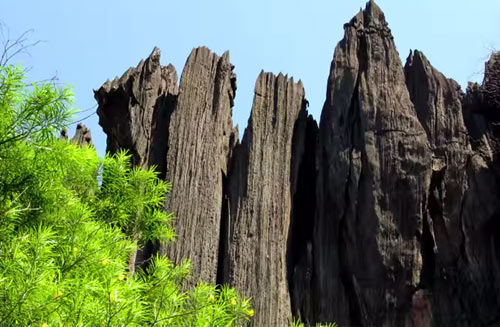Beyond the Beaches and the Temples - 4 Must-visit Places around Gokarna!
- Jonathan
- Feb 8, 2019
- 4 min read
Updated: Feb 14, 2019
Almost all descriptions of Gokarna invariably call it a temple town or a beach town or both. Gokarna’s identity is forged securely in it’s temple walls and rocky beaches.

Yes, it is without doubt a temple town and a beach town. But there is more to Gokarna than these two defining features. There are natural and architectural marvels around the place that would add a smidgen of variety to your regular vanilla beach retreat. So go ahead and add these unusual touches of history, nature and pastoral flavours to make your holiday in Gokarna holistic and just perfect!
Here’s a short list of must-see spots:
1. Yana Cave Formation
At a 35 Km drive from Kumta, to the interior of North Karnataka is the hill station of Yana famous for its breathtaking views and unusually upright limestone rock formation.

The two spiring peaks, the Bhairaveshwara and the Mohini peak crop up stunningly from the surrounding greenery of the Yana village. Trekking through the steep 3 km trail of emerald and grey to reach these imposing monoliths and enjoying the view of the mushroom shaped dwellings dotting the surrounding villages can be an exhilarating experience. And as if that is not interesting enough these rocks and the Yana village are steeped in mythological and religious folklore that can bind you in their captivating spells.
2. Mirjan Fort
If the unique rock formations of Yana and the nearby Mary’s Islands of Udupi go back in geological epochs, and the grand Mahabaleshwar termple takes us back to the Vedic times, the spectacular Mirjan Fort whisks us away to a more proximal time in history - Medieval India’s gripping throne games! There are conflicting versions of the fort’s exact origins - Some assign it to the Vijayanagara empire, some to the Bijapur Sultanate and some say a female ruler subordinate to the Vijayanagar Empire, Chennabhairav Devi from the Tuluva-Saluva clan held sway over the Fort and it’s Gersoppa territory for 54 years - the only female in the subcontinent to have had such a long reign (An extra reason to exult for the feminists amongst us!) The fort came into the hands of the Marathas and subsequently to the British before it fell into the ruins it is in today. But whatever remains of the once majestic fort is enough to pique our curiosity and kindle our imaginations about its glorious past.

The Fort is spread over 10 acres and built with laterite stones. Like other forts built around the time, the Mirjan fort was built to withstand severe battles. With four entrances, several wells, a circumscribing moat and escape gates, the plan of the fort evidences the defence acumen of the erstwhile empire. To see the remnant of this architectural treasure, the best time would be the post-monsoon season when the stone walls are clothed in a luxuriant robe of green moss, adding to the phantasmagoric feel of the fort!
3. Anshi National Park & Dandeli Wildlife Sanctuary
“The woods are lovely, dark and deep…” Robert Frost’s immortal lines capture the enchantment that a dense forest holds for mankind. Maybe the tropical rain forests 2 of the Sahyadri Hills are not fully comparable to the snowy temperate forests of America, but they beckon the nature buff and the photographer just as enticingly, with their cool breezes and soulful birdcalls. Anshi National Park is spread over an area of 340 sq kilometers at an altitude of 925 m above sea level. It was carved from the wider adjoining area of the Dandeli Wildlife Sanctuary in 1987.

You can drive through the picturesque road that cuts through the dense forest and stay at the Anshi jungle camp, treat your ears to the gentle gurgling of the water stream near the camp and catch the verdant view of the forest from the vantage of lofty watch towers. If lucky you can also spot the rare Tigers, Panthers Bisons, Pangolin and Sloth bears in addition to the more common Deers and Macaques. Bird watchers might have more reason to be delighted than the wildlife enthusiasts at Dandeli because the place hosts quite a few rare species like the Hornbills and Black crested Bulbuls. Whether you are blessed by the forest Goddess with sightings of wild animals and birds or not, you would still not regret the drive to Anshi, for as John Muir says “ There is no repose like that of the green deep woods” . So drive through the green canopies and hit the restart button of your life with the fresh vigour that the forest gifts you with!
4. Pavinakurva Hanging Bridge
Nestled in nature’s lap, is a man-made engineered delight - A hanging bridge at Pavinakura near Honnavar, at a 30 min drive from Kumta. Experience the thrill of walking haltingly on a slightly wobbly but safe bridge across the blue-green waters of the 3 Sharavathi River.

The Bridge connects the mainland Karki to the island village of Pavinakurve. Boat rides are available but you can also walk across for 20 minutes to the pristine Pavinakurve beach from where you can get a close view of the historic Basavaraj Durga Island. The scenic beauty of the place where river and see meet and glisten with the golden rays of the sun at dawn or dusk will be worth capturing in your cameras as well as your minds!





Comments